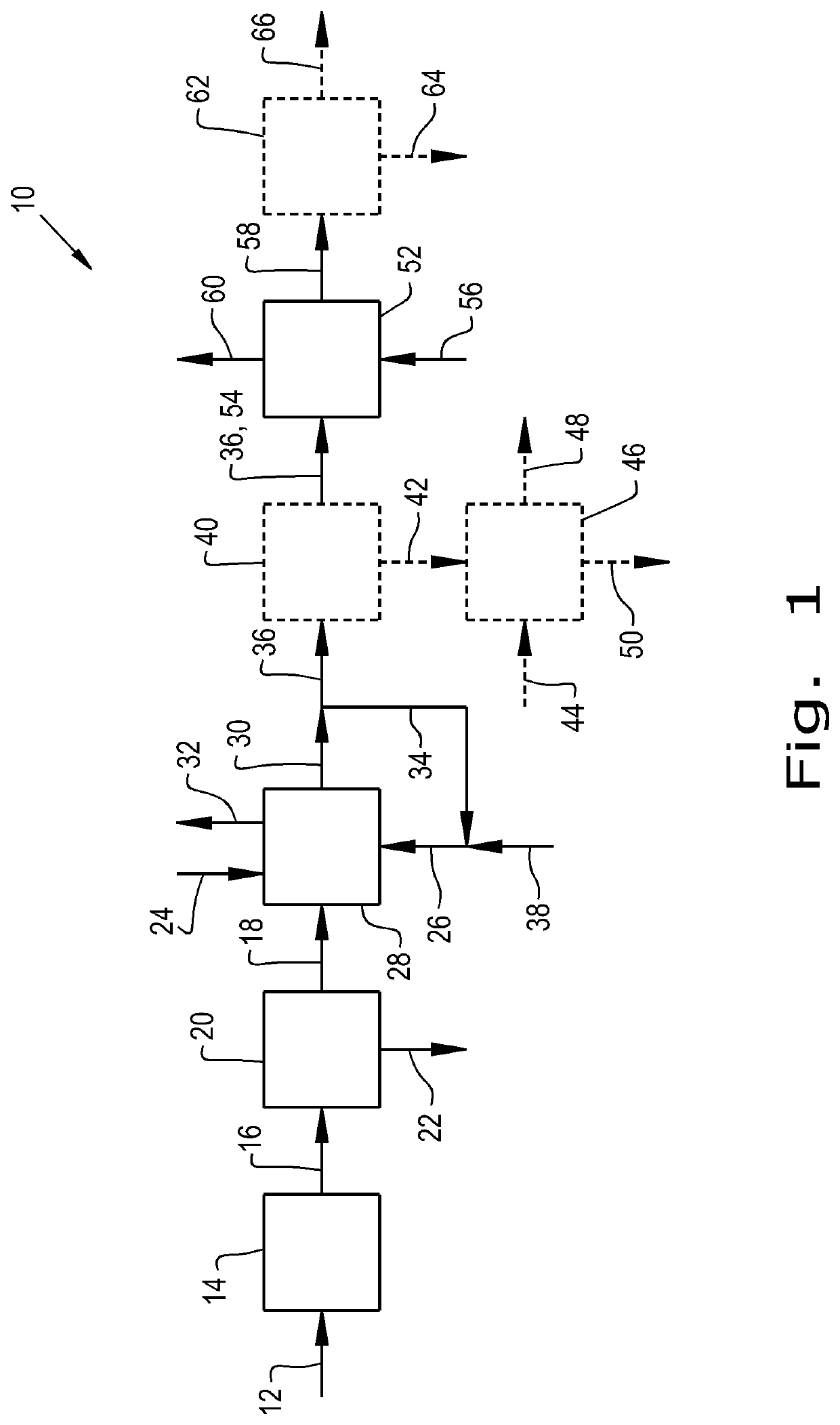Process for making esters of 2,5-furandicarboxylic acid
a technology of furandicarboxylic acid and esters, which is applied in the direction of separation processes, cation exchanger materials, ion-exchangers, etc., can solve the problems of microwaves in such a context that involve significant challenges and introduce their own complexity for a manufacturer
- Summary
- Abstract
- Description
- Claims
- Application Information
AI Technical Summary
Benefits of technology
Problems solved by technology
Method used
Image
Examples
example 1
[0061]Glucarodilactones (glucaro-1,4:3,6-dilactone, 28.99 grams, from Chemica Inc., Los Angeles, Calif.), 1-pentanol (300 mL, Sigma-Aldrich, St. Louis, Mo.) and concentrated sulfuric acid (3 mL) were placed in a 3-neck round bottom flask equipped with magnetic stirring, a Dean-Stark trap and condenser. The mixture was heated under argon to reflux and maintained at reflux for 4.5 hours, with continuous removal of water via the Dean-Stark trap. The contents of the flask were then cooled and rinsed with saturated sodium bicarbonate. The organic phase was then collected and rotovapped to remove unreacted 1-pentanol, and to the remainder (57.85 grams, containing both of the 2,3-dipentyl and 2,5-dipentyl furandicarboxylate esters as verified by NMR, as well as the monopentyl esters of FDCA, FDCA and some 2-methyl-5-pentyl furoate) were added twelve (12.0) grams of a solution of 30% sodium methoxide in methanol and an additional 210 mL of anhydrous methanol, for carrying out the second, tr...
example 2
[0062]Glucarodilactones as employed in Example 1 (10.95 grams), 2-ethyl-1-hexanol (110 grams, Sigma-Aldrich, St. Louis Mo.) and concentrated sulfuric acid (1.10 mL) were placed in a 3-neck round bottom flask equipped with magnetic stirring, a Dean-Stark trap and condenser. The mixture was heated under argon to reflux, and maintained at reflux for 2.5 hours with continuous removal of water via the Dean-Stark trap. 1H NMR showed the formation of predominantly bis(2-ethyl-1-hexyl) furan-2,3-dicarboxylate and the bis(2-ethyl-1-hexyl) furan-2,5-dicarboxylate. The contents of the flask were cooled and rinsed with saturated sodium bicarbonate. The organic phase was collected, and excess 2-ethyl-1-hexanol removed therefrom by short path distillation. Methanol (77 g) and a solution of sodium methoxide in methanol (3.24 g) were added and the reaction allowed to reflux for 1 hour. TLC analysis indicated the formation of 2,3-FUME and 2,5-FDME. The mixture was cooled and neutralized with a solut...
example 3
[0063]Glucarodilactones as employed in Example 1 (49.1 grams), 2-ethyl-1-hexanol (499.96 grams, Sigma-Aldrich, St. Louis Mo.) and concentrated sulfuric acid (2.45 mL) were placed in a 3-neck round bottom flask equipped with magnetic stirring, a Dean-Stark trap and condenser. The mixture was heated under argon to reflux, and maintained at reflux for 4.5 hours with continuous removal of water via the Dean-Stark trap. The contents of the flask were cooled and rinsed with saturated sodium bicarbonate. The organic phase was collected, and excess 2-ethyl-1-hexanol removed therefrom by short path distillation. A solids product was collected after washing with isopropanol and filtering. The collected solids were determined to be predominantly bis(2-ethyl-1-hexyl) furan-2,3-dicarboxylate while the bis(2-ethyl-1-hexyl) furan-2,5-dicarboxylate remained in the liquid phase, as determined by 1H nuclear magnetic resonance spectroscopy and liquid chromatographic analytical methods. The liquid frac...
PUM
| Property | Measurement | Unit |
|---|---|---|
| Amphoteric | aaaaa | aaaaa |
| Boiling point | aaaaa | aaaaa |
| Crystallization enthalpy | aaaaa | aaaaa |
Abstract
Description
Claims
Application Information
 Login to View More
Login to View More - R&D
- Intellectual Property
- Life Sciences
- Materials
- Tech Scout
- Unparalleled Data Quality
- Higher Quality Content
- 60% Fewer Hallucinations
Browse by: Latest US Patents, China's latest patents, Technical Efficacy Thesaurus, Application Domain, Technology Topic, Popular Technical Reports.
© 2025 PatSnap. All rights reserved.Legal|Privacy policy|Modern Slavery Act Transparency Statement|Sitemap|About US| Contact US: help@patsnap.com

